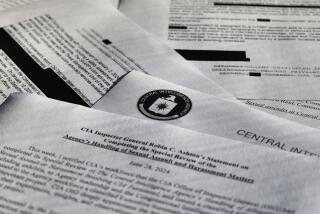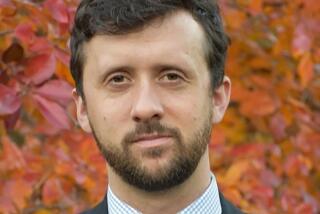Once Again, Ex-Agent Philip Agee Eludes CIA’s Grasp
- Share via
WASHINGTON — It was an aggressive, even reckless bit of espionage, allegedly committed by a man too well known for his own good.
CIA officials and other U.S. government sources charged that Philip Agee, a former CIA officer, author and CIA critic, went undercover as a spy for Cuba in late 1989 to try to pry secrets out of a female staff member in the agency’s Mexico City station.
U.S. officials alleged that Agee was acting on behalf of Cuba’s intelligence service, which has long staked out Mexico as a central espionage battleground with the CIA. Agee has denied the charges.
Agee, posing as a member of the CIA’s inspector general’s staff, tried to convince the staff member that he needed information about the Mexico City station as part of a secret investigation, the officials charged. CIA sources said that Cuban intelligence traditionally has targeted women staffers in their espionage operations.
The plot failed, U.S. officials said, when the CIA employee reported the contact and brought two CIA case officers with her to her second meeting with Agee. But one of the two case officers told Agee that he recognized him, the officials said, and Agee ended his efforts before enough evidence could be collected against him to bring formal charges.
The two CIA officers later were disciplined for their failure to notify their superiors of Agee’s alleged action early enough for the FBI to launch a criminal investigation of whether the former CIA agent had committed espionage against the United States.
Agee’s alleged willingness to act as a field agent for the Cubans astonished U.S. intelligence officials.
They said they believe that Agee--who quit the CIA during the Vietnam War in 1968 and later was known for his willingness to expose undercover CIA officers and operations through public lectures, magazines and books--has been working for Cuban intelligence since the early 1970s.
A high-ranking Cuban defector in 1992 told The Times that Agee had repeatedly taken money that the Cuban intelligence service had received from the Soviet KGB intelligence agency.
But CIA officers said that they had never seen Agee work openly as a field operative for the Cubans until his alleged approach to the female CIA staff member in Mexico City--an incident that remains classified.
In written responses to a series of questions from The Times, Agee denied that he was involved in the Mexico City case. He suggested that the story of his involvement in Mexico City had been inspired by the CIA to counter a lawsuit in which he is seeking damages for alleged illegal actions committed against him by the CIA in the early 1970s.
He stressed that he is not a Cuban agent.
*
“The story is one more in a long line of false allegations [inspired by the CIA] going back to the first mention of me in the New York Times of July 4, 1974,” Agee said in a faxed response from his home in Hamburg, Germany.
“As for Cuba, the CIA has for many years used the word ‘agent’ to characterize my relation with the revolution because to them it means ‘sold out,’ ‘controlled,’ ‘traitorous,’ etc. This is not the case, and I am no ‘Cuban agent. . . . ‘
“As is widely known, for more than 25 years I have been one more American working in solidarity activities with Cuba and against U.S. hostility, aggression, blockade, etc. etc. If this makes me a ‘Cuban agent,’ then there are certainly a lot of us out there.”
Agee was in Cuba in July at the invitation of the Cuban Committee for Peace and the People’s Sovereignty to attend an international student festival. In an interview with the official Chinese news agency, he alleged that the CIA had ordered the death of Ernesto “Che” Guevara.
Despite their belief that Agee has been a Cuban agent for years, the CIA and FBI have long been frustrated by their failure to gather enough evidence to prosecute him.
Although the State Department revoked his passport in 1979 after Agee proposed solving the Iranian hostage crisis by exchanging CIA files on Iran for American hostages, he apparently has traveled in and out of the United States without difficulty and has made numerous public appearances in this country.
In college lectures and extensive interviews, he frequently attacks the CIA as “criminal, immoral and against the interests of all but a very few Americans.”
But most galling to CIA officers is their belief that he is regarded as a legitimate critic of U.S. intelligence, not as a foreign spy. “The media treats him like any other former CIA officer with a point of view, but he is a traitor,” complained one former senior CIA officer.
In a speech at CIA headquarters on Sept. 17 during ceremonies marking the agency’s 50th anniversary, former President Bush, who served as CIA director in the mid-1970s, singled out Agee for his ire.
“Remember Phil Agee, who I consider a traitor to our country?” Bush asked the crowd. “The guy encouraged the publishing of names of those serving under cover, sacrificing their lives.”
Agee established his reputation as a critic of the CIA with the publication of his controversial 1975 book, “Inside the Company: a CIA Diary.” Published in 20 languages, the book exposed CIA actions around the world. At the same time, he sought to identify CIA undercover officers.
“It was not enough simply to describe what the CIA does,” Agee recalled in a recent television interview. “It was important to neutralize . . . the effectiveness of everybody doing it. And that’s why I was involved after my first book came out in the exposure of hundreds and hundreds of CIA people around the world.”
His second book, “On the Run,” published in 1987, described what he alleged was a CIA campaign to harass and silence him, especially during the years in which he was working on his first book.
More recently, he has been engaged in a legal battle with former First Lady Barbara Bush. Agee filed a libel suit against Mrs. Bush and her publisher for alleging, inaccurately, in her autobiography that Agee was responsible for revealing the identity of the CIA’s Athens station chief in his first book, just before the station chief was killed. The former first lady ultimately agreed to remove the allegation from her book.
But CIA officials said that Agee’s alleged actions in Mexico City took him far beyond the role of anti-CIA propagandist.
The female staff member whom Agee was said to have approached was apparently a member of the Mexico City station’s support staff and was not trained in espionage work. CIA sources said that they believe Cuban intelligence operatives steered Agee to her in hopes that she would not report his overtures.
Yet, she promptly went to a case officer in the station to report the contact, according to senior U.S. intelligence sources. She agreed to a second meeting with Agee, and two case officers went along.
*
One of the two recognized Agee and, according to some sources, told him that he knew who he was. Agee then quickly slipped away, the sources said. Later, the female staffer also identified Agee’s picture from mug shots shown to her by CIA officials.
For failing to notify their superiors soon enough about the incident, the two CIA case officers were not only reprimanded but also briefly taken off the agency’s promotion list. They were not fired because they had previously been considered among the best case officers in the Mexico City station.
“If they had notified their station chief and headquarters, we could have gotten the FBI involved for criminal investigation, but we lost that opportunity,” said one former senior CIA official who was involved in handling the matter. “And Agee got away.”
More to Read
Sign up for Essential California
The most important California stories and recommendations in your inbox every morning.
You may occasionally receive promotional content from the Los Angeles Times.










